
The term “romanticizing” surely applies to firearm enthusiasts and surplus rifles. We often take what is clearly no more than ordinary and hammer on it until it has a unique personality or it can perform acceptably. The Schmidt rifle as the Models 1911 and derivative K31, are perfect examples of this phenomena and I don’t think I am alone in that assessment.
“…It is also difficult to convert the Swiss rifle to handle any American cartridge and after conversion has been accomplished for something like the .308 Winchester, the owner still has a very clumsy rifle impractical for hunting purposes. The best advice to the shooting public is to let these military rifles alone except for collections. The same of Swiss, Italian and similar military rifles has been pushed by certain dealers, mostly because there is a lot of money in imported surplus weapons, which can be bought for practically nothing and sold to American shooters at a profit many times higher than could possibly be made on sporting rifles of American manufacture. This does not apply to all imported surplus rifles.” Parker O. Ackley – Handbook for Shooters and Reloaders – 1959.
There are some truths regarding the K31 that are self evident. While classified by the Swiss as a carbine, its barrel and overall length are half a foot longer than modern rifles with that type connotation. At just under 9 Lbs it is not a lightweight. Its straight pull action is weak, its cartridge maximum pressure rating is 15,000 psi less than even mundane U.S. cartridges chambered in value priced commercial bolt action rifles. The design of its bolt and actuating mechanisms offer the same failure protection to the shooter as the antique Marlin shotguns nicknamed “The Widow Maker”. Missing is the camming mechanical advantage of a turn bolt action that aids in extraction. The rifle’s safety is awkward to use, there are pieces of hardware poking out all over the place and there are much faster and more durable sights for hunting.
The K31 is not a war proven firearm and, as such, has no story of particular interest. That said, latter Schmidt rifles and the K31 are generally accurate, they do have an excellent trigger, they are moderate in price, and they are fun to tinker with as long as the owner doesn’t lose sight of the rifle’s potential. It is quite easy to run up gunsmithing services to $2,000 for stock work, barrel changes and rechambering to .308 Winchester, and installing precision sights, muzzle brake/damper. Roughly 1.5 times the price of a 1/2 MOA commercial target or varmint rifle.
In any event, I come not to praise the K31, but nor do I come to bury it. I buy them occasionally because I like the rifle’s shooting personality and I like to tinker and handload and see what level of accuracy can be achieved. Which takes us to the project agenda, which is to provide general firearm information, a bit of information regarding this specific firearm and then some considered handload data; performances and specifics. For further mechanical details, you may want to read an earlier article with that focus.
Background
The Vetterli served as Switzerland’s first bolt action, magazine fed rifle and remained the rifle of the Swiss military from 1869 to 1890. It was a platypus of a rifle with bolt housed in a tubular receiver perched atop a slab sided lower receiver walls and lever action repeater like tubular magazine. The magazine and feed system design was influenced by the 1860 Henry and 1866 Winchester.
Chambered for the 10.4x38mm rimfire cartridge, the Vetterli fired a 334 grain bullet at 1447 fps and was fed from an 11 round magazine. In 1886, conceding that the Vetterli’s short effective range and poor handling rendered it obsolete, the Swiss government ordered the Swiss military to find a suitable replacement. Skipping a lot of interesting developmental history, Major Rudolf Schmidt’s Model 1889 rifle, chambered for Lieutenant Colonel Eduard Rubin 7.5mm cartridge, became the Model 1890 Schmidt rifle.
There were a number of iterations in design. The cartridge grew more powerful and the rifles more refined. A strengthened Model 1911 rifle and carbine with locking lugs shifted forward were produced between 1912 and 1933. Introduced with this model was the .308 caliber GP11 cartridge that bumped operating pressure to 45,000 PSI; .323 caliber 7.5×53.5mm and .310 caliber 7.5×54.6mm operated at a maximum pressure of 37,000 PSI. Performance increased to a 174 grain bullet with a 2,500 fps muzzle velocity.1)2).
The changes that accompanied the K31 were significant enough to make this generation of firearm something other than a Schmidt design and to provide significant improvement. The action length, in comparison to the Model 1911, was reduced in length by 2.3″. As a result, the K31 is the same overall length as the K11, but at 25.65″ the K31’s barrel is 2.3″ longer. The bolt length was cut nearly half, the bolt extension was removed and the lugs remained in the same location at the front receiver ring for strength, but this time as part of a bolt head that was integral to the bolt body.
The shortened action and bolt allowed the magazine to be moved back 2.3″ and out of the way of a proper shooter’s hold. The proportionally shortened stock cut 1.45 pounds from the rifle’s weight. The walnut stock, as pictured, was used in early production. Over a half-million K31s were produced between 1933 and 1963 with an additional 600 produced between 1968 and 19721).
|
K31 Carbine |
|
| Manufactured | Swiss |
| Type | Straight Pull Bolt Action |
| Caliber | 7.5x55mm (As marked) |
| Mag Capacity | 6 |
| Barrel Length | 25.65″ |
| Rifling | 1:10.63″ (270mm) |
| Weight – Actual | 8 Lbs 12 Oz. (Actual) |
| Overall Length | 43.6″ |
| Stock | Walnut |
| Hardware | Blued Carbon Steel |
| Length of Pull | 12 3/4″ |
| Drop at comb | 1″ |
| Drop at heel | 1 1/2″ |
| Sights | Tangent Rear – Post Front |
| Scope | No accommodation |
| Trigger | 4 Lbs. 7 Oz. |
| Safety | Rotating Cocking Piece |
| Typical Retail Price | $329 |
GP11, 7.5×55, 7.5 x 55 Suisse, Cartridge 11
There 1958 Swiss Army manual for the K31 indicates a firearm pressure ceiling of 3200 bar, the calculated equivalent of 46,401 psi. Here the public dialogue, and even some print publications, take a good deal of license in interpreting that number. The Swiss manual defines a “Cartridge 11” by bullet type, by performance and even by non-specific nitrocellulose stick powder charge, however, at no point does it reference chamber pressure. Yes, I have read the popular books that cite “45,000psi” at the specification for the firearm, however, I have never seen a source document from the period of the rifle’s production that pronounces such a figure and there is no pressure conversion calculation I am aware of that would yield that result.
CIP lists the 7,5 x 55 Suisse, which some folks feel is synonymous with the Cartridge 11, with a Pmax pressure of 3800 bar. This is the equivalent of 55,101 psi, nearly 18% higher than the Cartridge 11. I have not seen the terminology 7.5×55 Swiss in any source documents of the day for the K11 or K31, nor have any K31 rifles been marked as 7.5×55 Swiss or any other cartridge for that matter. The electro-pencil markings and importer tags and documentation indicate only 7.5×55. All very odd as the Swiss are not known to be an imprecise people.
My interpretation is that the 3200 bar (46,401) psi is the pressure limit specification for both the K11 and K31 firearms. The Cartridge Type 11 was loaded to honor the 3200 bar pressure limit, the 7.5×55 Swiss defined by CIP is a civilian sporting rifle cartridge. The two are not synonymous, much like the 5.56 NATO is not synonymous with the .223 Remington cartridge. I would be glad to alter that opinion in the presence of period documents; not firearm forum discussion, web site content without traceable or verifiable sources, not a more recent book that lists sources that do not substantiate stated facts and conclusions. I am not trying to be difficult, it’s just that handloading is not a casual endeavor.
All of the handload data previously posted for the 7.5×55 is being overhauled and will be included in Part 2 for two reasons. The load data was developed with a rifle that was throated to clean up pitted rifling ahead of the throat. This permitted longer overall cartridge lengths than typical, which would not be of much use to others. Finally, I want to reshoot and pressure check all posted loads. Some of the load advice I’ve seen in public posting ranges from good to dangerous and a good deal that is irresponsible. One of my favorite is “Just use .308 Win start load data and work up from there. A start charge for the 308 Win is approximately 94% case full and generates about 47,000 psi. The same charge in the 7.5×55 is a 75% charge and generates only 34,000 psi of pressure which can yield erratic results.
The subject rifle

This particular K31 was purchased from Aim Surplus as a retail purchase and is not exceptional for that supplier. The matching number rifle was manufactured in 1942, as verified by serial number placement within a range and by the stamp on its bolt body.
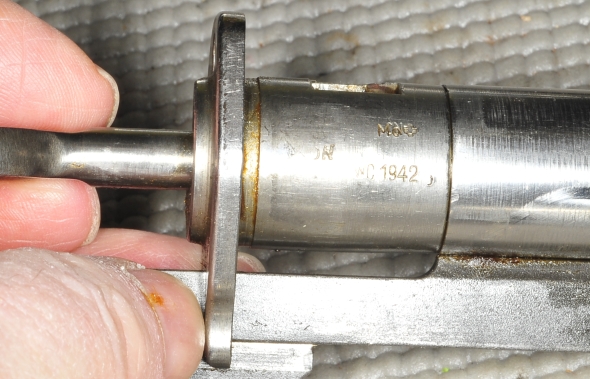
Further verification came from a matching stock with a 1943 dated soldier’s tag under the buttplate and a “V42” stock stamp representing May 1942. An indication of how even credible publications don’t cover everything, Poyer’s book indicates that walnut stocks were found only in very early production, however, this firearm was produced ten years into the production cycle.
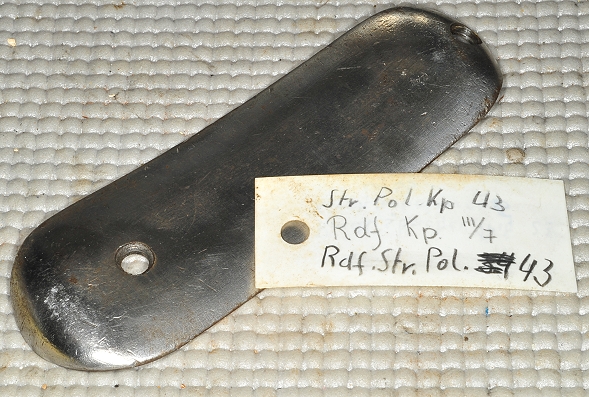
This picture below was taken BGR… Before Gunk Removal, but the rifle was free of rust, pitting, bluing is about 95%. The stock has the usual puncture wounds common on every other Swiss 1911 or K31 that has found its way into the shop.
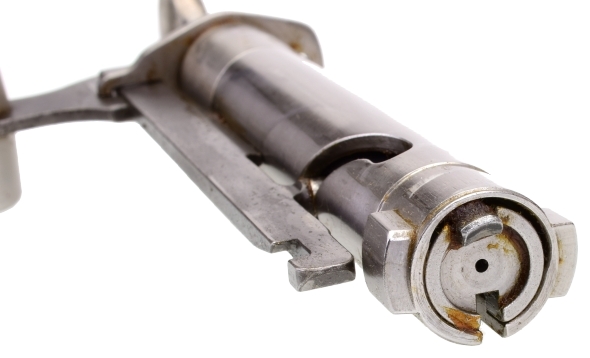
Two of the more important factors, after cleaning to remove preservative, the bore proved to be bright, the rifling sharp and the chamber pristine. Finally, the trigger is terrific without any finagling; a good deal of pretravel, but without creep, clean break at 4 Lbs. 7 Oz. and no perceptible overtravel.
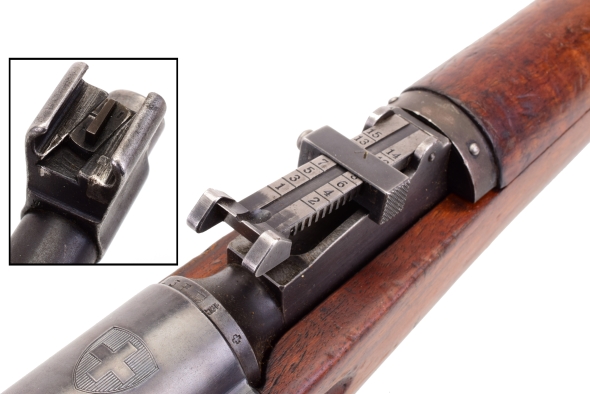
The sights are interesting even if like most other military sights. I can’t hunt with this type of sight; just can’t find the small notch against a mottled background, but they are not a problem for range work. Sometimes they are fun to use for a little friendly range competition and the 1,500 meter increment is always good for laughs.
With the rifle checked out and cleaned. I’ll take a break to work on some other projects while some handloading tools are in transit, and then I’ll be back with live fire, factory and handloads and something worth sharing about those processes.
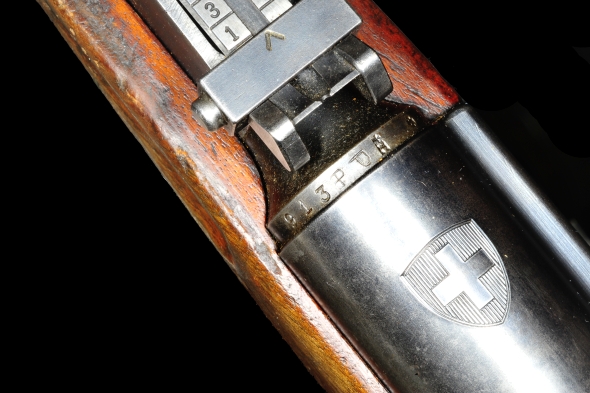
1) “Swiss Magazine Loading Rifles 1869-1958” Poyer 2003
2) “The Book of the Rifle” Fremantle 1901

Email Notification